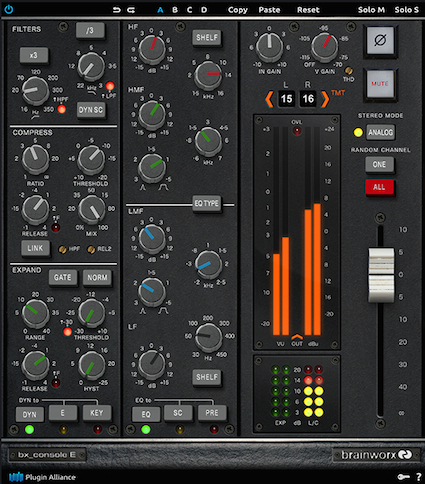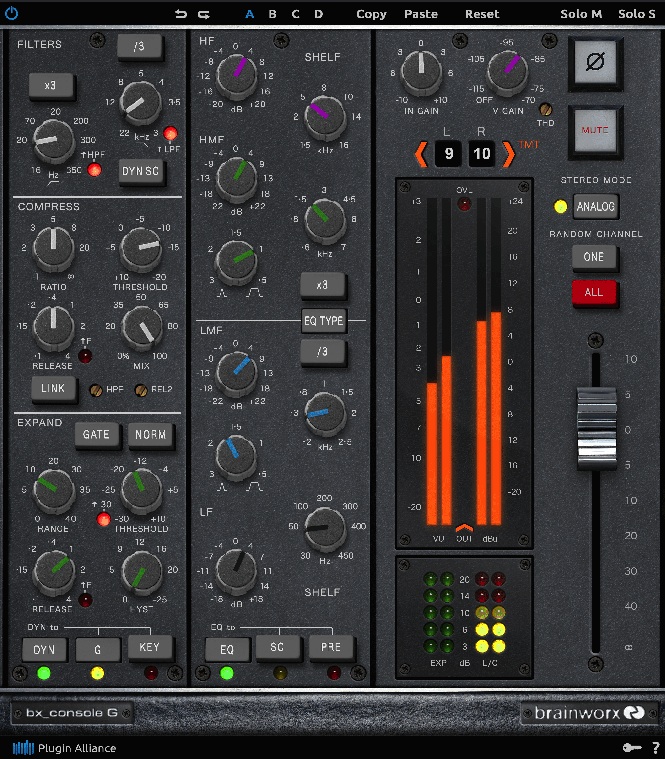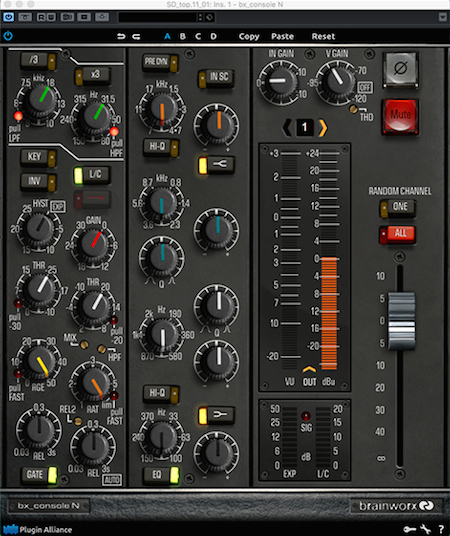New Gear Review: bx_console Collection by Brainworx
There’s no doubt that there is a huge market for plugin emulations of classic hardware. Music makers of all kinds often aim to capture the sonic footprint of their favorite vintage gear, without having to break the bank to get there.
Brainworx, distributed by Plugin Alliance, is already well-known for its contributions in hardware modeling. Now, with the bx_console Collection, Brainworx aims to put the sound of three iconic large format consoles into the hands of today’s engineers.
Between their emulations of the Neve VXS (bx_console N) and the Solid State Logic E and G series (bx_console E and bx_console G), the company has gone to great lengths to meticulously model these plugins’ namesakes while also adding some key bonus features that are now possible in the digital domain.
All three console plugins boast mostly similar functionality, beginning with Brainworx’ proprietary Tolerance Modeling Technology, or “TMT”.
TMT is based on the idea that the audio components within any given channel of a console have varying acceptable tolerances from an ideal—anywhere from 0.1% to 20%, depending on the component.
These variances mean that each channel in an analog console sounds a little bit different, and it’s the combination of these differences that creates part of the magic of the large-format console sound.
There are many console modeling plugins on the market, but because TMT focuses on the individual components per channel, it provides incredible possibilities in terms of variety of tone and realism.
All three plugins in the collection have 72 different available “channels,” and since the plugins are very processor-friendly, it’s easy to create a virtual console with the special sauce of an analog one.
The Similarities
Apart from these under-the hood similarities, the consoles also have similar GUIs. Each boasts a filter section, a dynamics section, an EQ, and a master section.
The filter sections are as one might expect: They include a high pass and low pass filter with the ability to change the frequency by a factor of three. (This changes the range of each filter to be 3x higher or lower than the stated value, making them quite flexible.)
The dynamics section on each console offers a compressor with the usual parameters: threshold, ratio, and release. All three also add the modern conveniences of a “Mix” control (for blending the dry signal with the processed signal), and high pass sidechain filter.
Along with the compressor, each channel strip also has a gate/expander with controls for range, threshold, release and hysteresis. All three also include an “INV Gate” switch, which toggles between normal gate mode and inverse, where you hear what the gate is removing. This is helpful for setting the gate of course, but can also be a cool effect!
Each of the three consoles features a four-band EQ section with two fully parametric and two shelving bands, capable of being switched pre-dynamics, or placed in the dynamics sidechain.
There is the option to switch to a peak filter in all cases except for the “Pink”-type EQ on Console G, which functions as a high frequency shelf only. Lastly, each channel strip has a similar master section with metering, input gain, mute and polarity switches, as well as TMT controls and a “V Gain” knob, the last of which simulates the natural levels of noise found in analog circuits.
The Differences
With all three consoles sharing so many similarities, what are the differences that make each of them unique?

bx_console E features the not-so-subtle sonic footprint of the SSL E Series desks, most notable for its punchy dynamics and forward-sounding EQ.
The first difference is a small but noticeable one: Because they are based on the designs of two different manufacturers, the layout of the knobs is a little different on the bx_console N compared to the G and E versions.
On the N model for instance, the filters are reversed with the low pass on the left.
The layout on the dynamics section is also a bit different, with the gate controls on the left and the compressor on the right in the console N, instead of one over the other like in the SSL versions.
The same holds true for the EQ section, where the frequency control knobs on the mid bands are “upside down” in comparison to the SSL-style controls.
Just as in the filter and dynamics section, this is only a cosmetic difference inherited from the original consoles layouts. But it is something to take note of in your workflow. So be warned: if you’re using various versions in a mix and working fast, pay attention to which knob you’re turning!
The dynamics sections all have the same base set of parameters, with a few minor exceptions. One great option is the ability to switch between the E and G dynamics sections of the SSL versions. (The G series had updated VCA chips, which are part of its cleaner and more midrange-forward sound.) Console N boasts a convenient Makeup Gain knob, but lacks the secondary release functionality of its counterparts.
The EQ sections are where things start to differ more. The Console N has the warm and round tone one expects from a Neve EQ. Meanwhile, despite being based on consoles from the same parent company, the E and G Consoles have two very different sounding EQs.
The G channel has a cleaner tone with its steeper filter slopes and proportional Q design, meaning the more you boost or cut, the narrower the Q becomes. This makes for a broader boost or cut when making small adjustments, while bold EQing will be more precise. The Console E EQ retains its constant Q design, making it more aggressive at all gain levels.
The SSL-style EQs set themselves even further apart with multiple revisions of each console, which Brainworx includes via the “EQ Type” toggle switch.
On the Console E, the switch toggles between the Brown and Black circuits. The Black Knob design was an update to the original Brown version, with an increased boost/cut range and a steeper high pass filter.
On the Console G, you can switch between the Orange and Pink circuits, with the Orange allowing the shelves to be switched to peak filters. The Pink version, while having the high and low bands fixed as shelves, also adds frequency multipliers to the mid bands, greatly increasing their range and flexibility.
In Use
So how does one choose between the three? I’ll begin by saying there is no “best” or “worst”—these are three different but great sounding tools.
If I were to generalize, I would say Console N is smooth and warm, Console E is aggressive-yet-musical, and Console G is the cleanest and most surgical of the three. Beyond generalities, after spending time with all three, I found myself reaching for each of them in different situations.
I found the N channel to be my go-to for vocals. The smoothness of the compressor, along with the warmth and musicality of the EQ section, provided a big and full tone for any voice I ran through it. These attributes were also great for bass, keyboards, and anything else I felt needed some size.
The SSL E series is legendary for drums (especially hip-hop), so it was no surprise I gravitated to Console E for kicks, snares, toms, and anything that goes bang! Both EQ circuits sound great, so that simply comes down to a matter of taste. And with the addition of a Mix control, sidechain filter and secondary release control, the dynamics section is more flexible and better than ever.

Console G offers added flexibility in its EQ and dynamics sections, making it the most versatile of the bx_console collection.
While Console G is the least colored of the set, the number of options in the EQ section make it the most versatile.
The proportional Q design, coupled with the shelf/bell or midrange frequency multipliers, make it a flexible and surgical beast.
The standard compressor is the most aggressive of the bunch, but the option of the E series dynamics just adds to this plugin’s versatility.
Because of the “forward” compressor sound, the Console G is also great on snares, but I found it great on guitars, overheads/room mics, and vocals as well.
To Be Critical
I mentioned above the location differences in some of the knobs, and while it’s not a huge deal, it does require you to pause and think about what is where.
I recognize that the difference in the layouts is inherited from the design of the original consoles. However, while it would be rather uncommon to quickly jump back and forth between physical SSL and Neve consoles, one would often be switching between the two in their DAW. With so many other features here being so similar, that mental adjustment may matter to some. Another cosmetic concern is the size of the GUIs; all three take up a decent amount of screen real estate.
Also, I know component noise is a reality in the analog world, and some say it’s part of the magic of a large console. But I for one am not among those who want it replicated in plugins. Before setting the default to have this feature disengaged, I would find myself searching through sessions wondering where that noise was coming from. Although the manual advocates for adding a -85dB noise floor for the most authentically-analog experience, I do appreciate that the V Gain is variable and easily switched off.
Summing it Up
All hardware emulation plugins are not created equal, and Brainworx did an amazing job with the bx_console collection. Their TMT technology allows for not only realistic modeling, but also varying characteristics in all 72 channel options, greatly increasing the realism and versatility.
The three plugins cover just about any need that can arise, from surgical correction to vintage vibe to raw aggression. And with a very light CPU load, you can easily create custom consoles that work together from channel to channel—just like their large analog counterparts.
At $300 per plugin, it is no small investment to own all three options, although Plugin Alliance often has great sales and discount vouchers. If budget is a concern, consider what holes in your plugin collection need to be filled the most. But don’t fret too much—while each console may excel in different areas, all three are certainly versatile enough to work in most situations.
With the bx_console N, G, and E, Brainworx has succeeded in making some of the best-sounding and most accurately-modeled console plugins on the market today.
Please note: When you buy products through links on this page, we may earn an affiliate commission.







